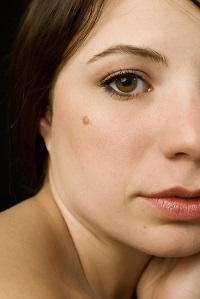Almost all adults have a few moles scattered across their bodies; the average amount is between 10 to 40 moles. If you've wondered  about the size, shape or appearance of any of your moles, our dermatology professionals at South County Dermatology in Narragansett, Westerly, Barrington and East Greenwich, RI have some basic information for you.
about the size, shape or appearance of any of your moles, our dermatology professionals at South County Dermatology in Narragansett, Westerly, Barrington and East Greenwich, RI have some basic information for you.
What are moles?
When skin cells called melanocytes bunch up in a small, rounded cluster rather than spreading out evenly, a mole, or nevus, develops. Moles can be flat or raised and are usually a different color than the skin surrounding them; they can be pink, tan, red or brown. People with lighter skin tones typically have more moles. While most moles are normal and harmless, some can have irregular properties like notched borders, varied colors or diameters larger than 5 millimeters. Many of these moles are atypical or dysplastic, which means they are benign but have physical features that mimic cancer. However, if these features develop suddenly, it can be indicative of skin cancer. In these cases, the mole will need to be removed by your Narragansett, Westerly, Barrington and East Greenwich dermatologist.
What is a cancerous mole?
There are three basic types of skin cancers that arise from moles: basal cell carcinoma, squamous cell carcinoma and melanoma. The first two are more common and less likely to spread to other areas of the body, while melanoma can be life-threatening if it spreads, or metastasizes. The good news is that by visiting your dermatology office once a year for a skin check, you increase the likelihood that any skin cancers will be detected early, which in turn greatly reduces your risk for developing metastasized melanoma.
Why are moles removed?
There are several reasons why moles are removed from a patient's body at our dermatology practice. It could be a cosmetic issue; some visible moles on the face, neck or chest can be distracting. Other moles might be in a location where they are constantly irritated by clothing or jewelry. Other moles might display properties of dysplasia or cancer that our dermatology professionals want to investigate further, and by removing these moles, they can be analyzed in a laboratory.
To schedule an appointment for a skin check or any other dermatology-related issue, contact South County Dermatology in Narragansett, Westerly, Barrington and East Greenwich, RI today!
